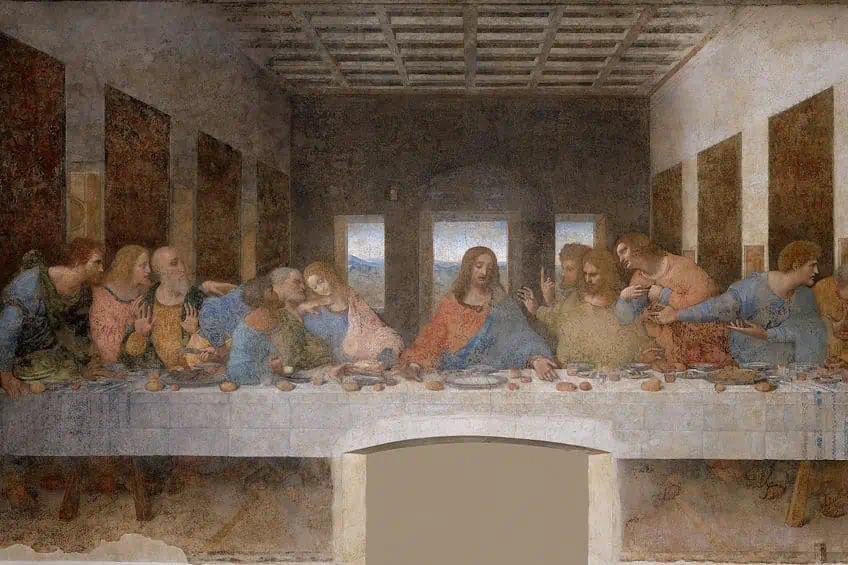Medieval Art – Different Themes and Periods in Medieval Art
In the Western world, Medieval art takes up a large portion of time and place within the time span of 1,000 years of art in Europe as well within Western Asia and Northern Africa at certain periods. The early 14th century is thought to mark the end of Medieval art, which is thought to have started with the decline of the Roman Empire. At the time, Medieval art had a significant impact on Western art culture. Due to the span of time that the Medieval period took up, many different forms of art were created, including paintings, sculptures, textile arts, manuscripts, metalworking, mosaics, and stained-glass windows. Below, we will be going into the specifics about many of the aspects of Medieval art.
Contents
What Is Medieval Art?
The term “Medieval art” generally refers to works of art that are recognized as having been produced in Europe between the 5th and 17th centuries CE. Many major art movements developed within this period. The early Christian church’s iconographic practices and the creative legacy of the earlier Roman era both had a significant influence on Medieval art. The medieval period was a synthesis of two artistic legacies.
Medieval art ultimately produced some highly recognizable works of art as a result of the merging of forms because of the distinctive aesthetic style that emerged.
The period can be dissected into numerous different distinct periods and styles due to the vastness of the Medieval art period. Early Christian art, Byzantine art, Pre-Romanesque and Romanesque art, and Gothic art are some examples. Each region within Europe had a unique art style in which they each exhibited, in addition to each of the different styles, which meant that the Medieval art pieces within different regions created differed greatly from one another even though they were created within the same period.

A large variety of different artistic mediums were used to create Medieval art. These mediums included sculpture, illuminated manuscripts, tapestries, stained glass, mosaics, and metalworks. Different styles were used to create numerous different artworks. Due to the mediums used to create these artworks they would usually last longer than other mediums such as fresco wall paintings. Artworks created during the Medieval era consisted of highly decorative details such as precious metals, ivory castings, enamel, and embroidery. These adornments were thought to be of higher value than traditional painting or sculpture.
Utilizing priceless and precious materials became a widespread practice during the Medieval era, which is also what made the time period well-known. The Medieval period of art came to an end with the advent of the Renaissance, which coincided with the resurgence of the qualities and ideals associated with classical art that had been ignored for centuries.
Medieval art and its vast range of achievements had set up the start for future Western art forms that would later come to light.
A History of Medieval Art
The Aesthetic legacy that was carried by the Roman Empire made its way to the future of Medieval art within Northern Europe. The period leading up to the development of Medieval art was known as a highly instructional period in Europe’s cultural history after the demise of the Roman empire in 476 CE Medieval art consisted of numerous types and forms of diverse media, which made its way up until the early beginnings of the Renaissance in the 14th century.
Due to the many different forms of art that were encompassed by Medieval art, it is said to be incredibly vast as the era lasted for multiple centuries as well as gave birth to many different genres.
Some of the works produced during the heyday of Medieval art, which was prevalent in parts of Europe, the Middle East, and North Africa, are regarded as some of the most priceless works of art in existence today. These works of art were mostly shown in churches, cathedrals, and other religious doctrines and worship spaces. As the style was heavily influenced by the early phases of Christian art and the “barbarian” culture of Northern Europe, gold was a popular material during the Medieval art era and was employed in creations like religious texts.

A large and varied range of artistic styles and periods came with the development of Medieval Art. Depending on where in Europe they were displayed, each piece of art was unique. Three main notable phases of Medieval art came out of the era due to the large vastness of styles that had emerged. These three periods are the Byzantine, Romanesque, and Gothic eras of art. Most of the art that was created during the Medieval period was of religious influence and often would make use of Catholic subject matters and themes.
Feudalism predominated in society during the Medieval era, also known as the Middle Ages. Feudalism, which was the dominant socioeconomic framework during the Middle Ages, allowed the nobility to effectively control and rule all the lands. The members of society, from the wealthiest to the poorest, all had to answer to the nobles who controlled their lands.
Being largely different in lifestyles was the divide between the two social groups. The wealthy members of society would live a life of luxury, power, and status and the poorer members of society would have trouble with everyday life and with the expectancy of a life of service to those above. Because of this difference in lifestyle and large division was created between the two groups. The only common ground of all the members of society was the presence of religion Christianity in Europe.
Because religion was such a significant aspect of daily life during the Medieval era, many people in the early Middle Ages were also painters in addition to becoming priests and monks.
Due to the large extent of illiteracy during this period, Medieval artists and their religious artworks were to be the main source of communication between religion and society. This led to the need for more Medieval artists to create art as a form to express detailed stories and symbolism to all of society. Due to the need to adhere to these criteria, Medieval art pieces were significantly more stylized than earlier works because the movement missed the classical naturalism linked with the Greco-Roman era during the majority of the movement.
Due to the absence of literacy during the Middle Ages, monks and nuns could employ an expanding number of printed materials to interact with the populace by copying illuminated manuscripts, which themselves developed into an art form. With the narratives of religion being favored, there was a shift from the production of naturalistic images to images being able to express intricate stories. This change profoundly influenced the medieval aesthetic and started to include abstracted figures in a lot of the early Medieval art. Thus, in addition to paintings, sculptures, and manuscripts, the Medieval period also created many architectural plans for churches, castles, and monasteries.
Medieval artists would commonly work with well round craftsmen including carpenters, woodcarvers, masons, sculptors, metal workers, and painters. These craftsmen would help with the application of decorative elements to the artists artworks. Lesser-known craftsmen were influenced by the artists works such as locksmiths, weavers, blacksmiths, and shoemakers. The Medieval style was imitated in the objects that they created.
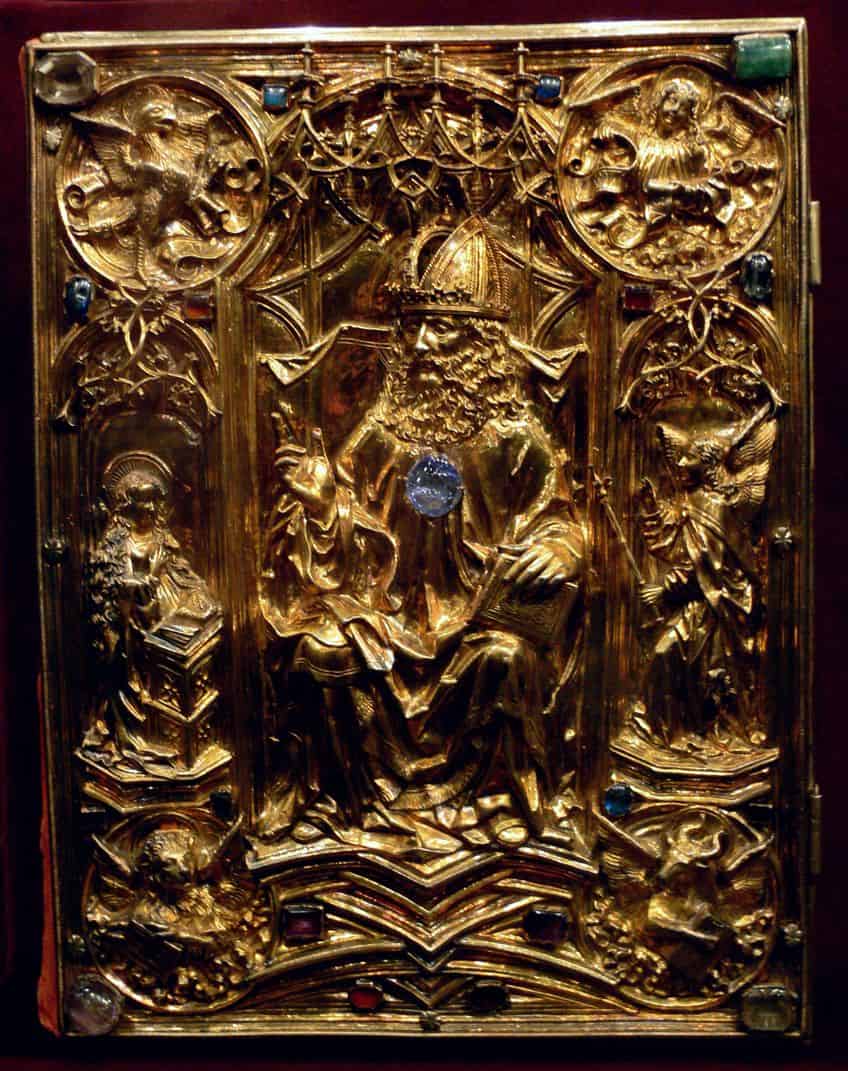
Medieval art was so profound as it not only existed for pure aesthetic but as well for symbolism for one’s status, culture, education, and identity. What went on to further define artworks was the major changes that took place in Europe during the Medieval era such as societal, artistic, and cultural changes.
The changes in art that came after the start of the Renaissance period were thought to signal the end of Medieval art, despite the fact that neither its beginning nor its end could be pinpointed.
Due to the large number of works from the time that were deemed to be historically significant, the medieval era is still a popular subject of study for art critics, students, and collectors. The achievements of the movement’s artists have had a significant impact on the evolution of contemporary Western art genres that have since arisen. As a result, the Medieval period may be regarded as one of the most significant aesthetic periods in history.
Early Medieval Art
Since it contains works from as early as the 5th century CE and as late as the year 1000 CE, the early Medieval art era is highly intricate. Early Medieval artworks also show a variety of cultural influences, combining Christian themes and decorative patterns from the pagan North with classical Greek and Roman creative elements. Other projects that were employed by the Catholic church, as well as other rich sponsors, came about at the beginning of early Medieval art, and the artworks were made for things such as social and religious ceremonies.
Artworks that were created by artists during the early Medieval times were required to showcase Biblical narratives and classical themes.
These artworks were specifically created to be featured in churches with the insides being detailed with ornamentation of Roman mosaics, complex paintings, and marble incrustations. Due to the religious significance of the artworks, most early Medieval artifacts are kept in Roman tombs or urban graveyards.
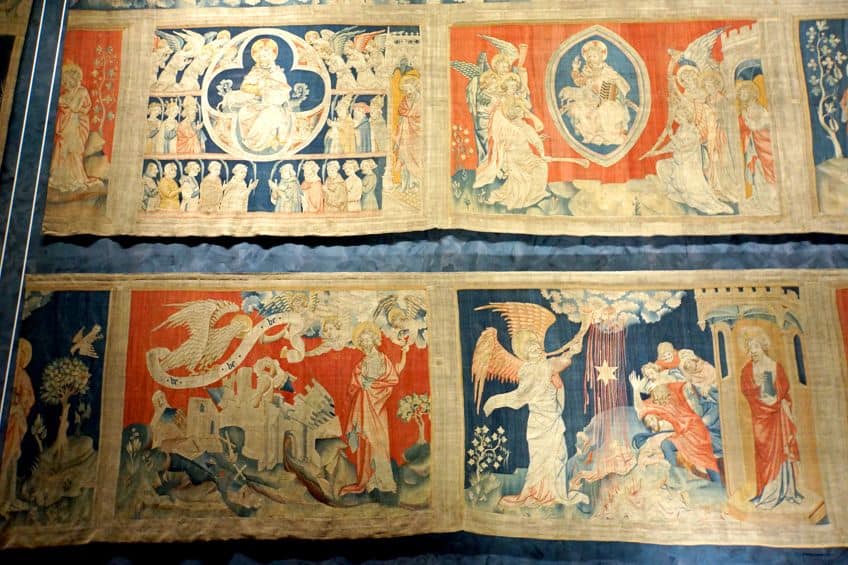
There were many forms of artistic styles that had emerged before the beginning of early Medieval art, and they would frequently refer to the previous styles for inspiration. The use of relief sculptures was frequently looked back upon for inspiration for early Medieval art as the art of the time progressed. These kinds of sculptures were unique and influential since they were created to stand out from the background to create a 3D-like effect. Ivory was the preferred material used by Medieval artists to create intricate sculpted designs that were used on book covers, panels, devotional items, doors, and caskets.
Another popular type of art form that was widely used by Medieval artists was frescoes and mosaics, which were frequently used to adorn palaces and churches. The Blessed Virgin Mary and the ascension of Jesus was a prime example of the detailed designs that were to portray Christian scenes and saints. The style of artwork was frequently flat in style lacking shape and form due to the lack of realism that came with these artworks. This would lead to the subjects having a somber feeling. Relief sculptures, frescoes, and mosaics were frequently used as decorations in churches and palaces during the early Middle Ages. While these structures’ architecture was primarily Roman, there was an unmistakable Christian influence on their aesthetic flair.
Although early Medieval art kept some historical forms and methods, such as stylistic components from the Classical era, it also started to establish new forms and ways of doing things that would later fundamentally alter the field of art.
Medieval Art in Its Four Divisions
Since the Medieval art period spanned 10 centuries and a wide range of space and time, numerous types and genres of art were explored and used during this time. Because of how the Middle Ages viewed religion and faith as a manner of life, the majority of European towns’ cathedrals served as the canvas for artworks that depicted many social, political, and historical events. Medieval art is typically grouped into numerous categories based on the diverse sorts of artworks that were produced, which were expressed differently in various locations and periods.
As independent artistic movements, the early Christian period, the Byzantine period, the Romanesque period, and the Gothic period have all been identified.
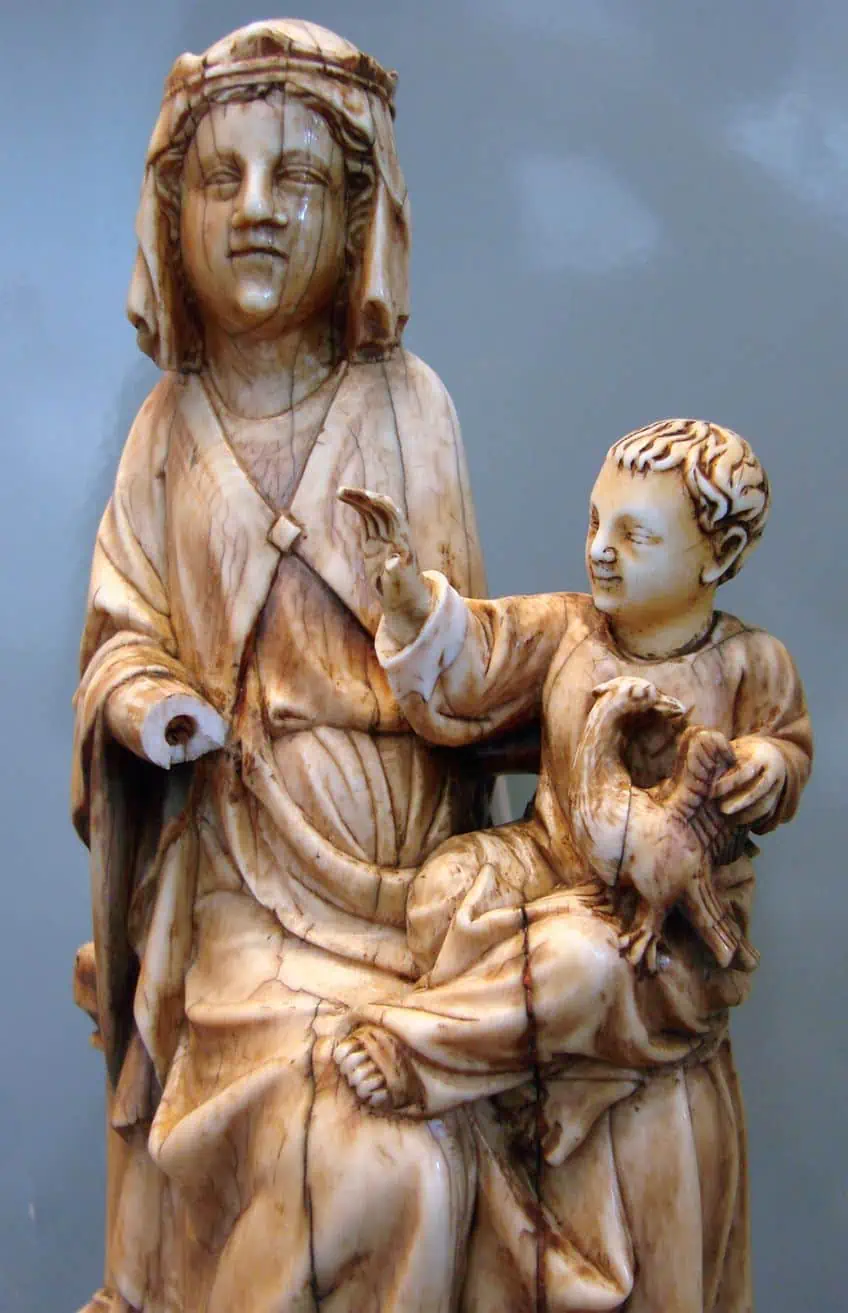
Early Christian Period (31–324 CE)
Religion and Christianity turned out to be significant effects on the early Medieval art movement. Since the majority of the paintings depicted Biblical subjects, they frequently included references to religion and spirituality. The Eastern Mediterranean region’s neighboring nations to some extent contributed to the creation of early Christian-period art. However, central Italy was the primary region from where this artistic movement arose.
Following the official adoption of Christianity as the state religion by the Roman Empire, early Christian artistic forms emerged. Christian art gained popularity in the 4th century as images of Christ proliferated. As more Medieval artists started to construct scenarios that portrayed Jesus and other religious figures, worries about representing the Deity in artwork grew.
The early Christian art period began at the beginning of the Medieval art era, which explains why only a small number of sacred artworks and designs from the first three centuries of Christian art have survived. Catacombs are where the majority of early Christian artworks found today, including famous paintings, originate. Despite this, there are still some instances of early Christian architecture because so many churches were built during this time.
Byzantine Period (395 – 1453 CE)
In Constantinople, the capital of the Roman Empire at the time, the Byzantine period of art was beginning. Byzantine art predominated as the major style of art employed by painters from the Eastern Roman Empire at the start of the Medieval era, which was known as the Dark Ages. The general characteristics of Byzantine art (c. 4th–c. 15th century CE) are a shift away from the naturalism of the Classical tradition toward the more abstract and universal, a clear predilection for two-dimensional depictions, and a predominance of works with a religious theme.
Although many motifs are continually reproduced, by the 12th century CE, Byzantine painting had become much more expressive and innovative. There are also distinctions in the period’s specifics.
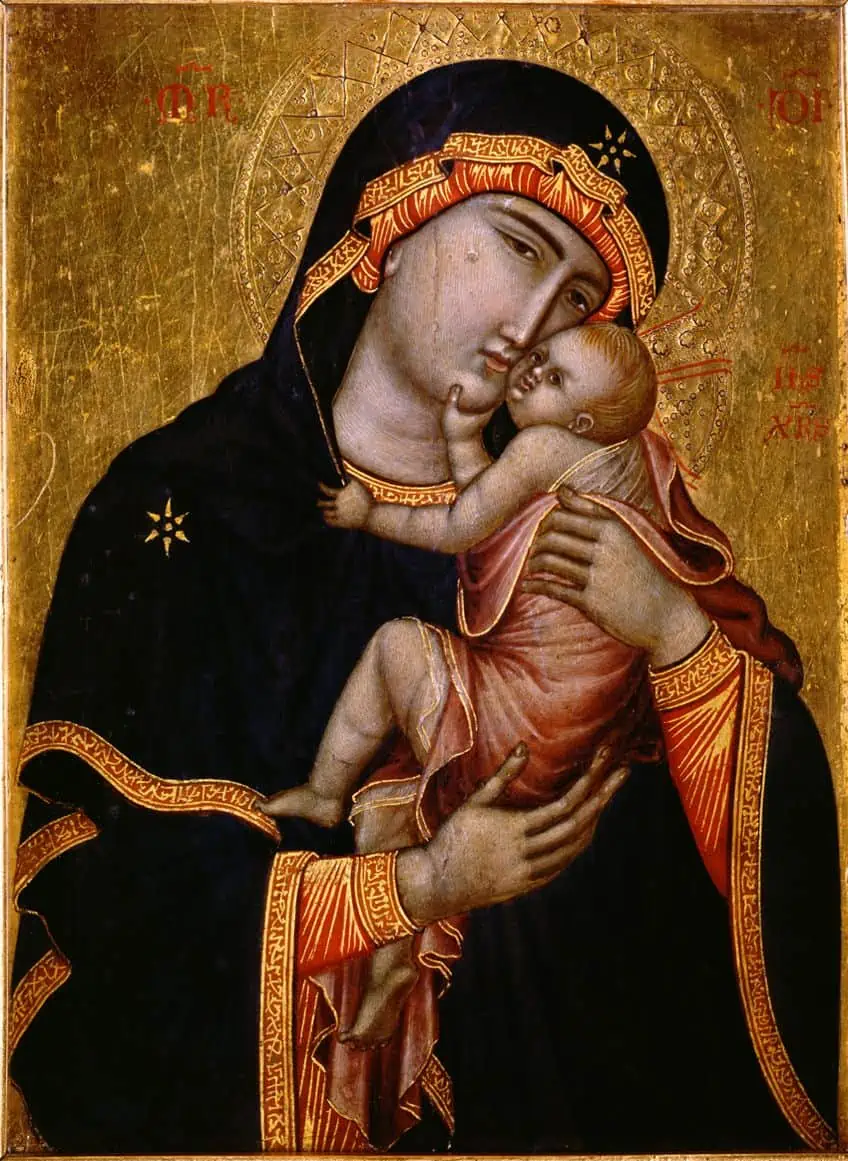
While it is true that the bulk of remaining artworks has religious themes, this may be the consequence of selection in later centuries as there are many allusions to secular art in Byzantine sources, and paganism-themed artwork was still being made far into the 10th century CE and beyond. Byzantine artists used vibrant stones, gold mosaics, vibrant wall paintings, intricately carved ivory, and other precious metals to beautify everything from buildings to books, but their greatest and most enduring contribution is unquestionably the icons that are still used to adorn Christian churches all over the world.
Buildings constructed during the Byzantine era were frequently vast and opulent, serving as symbols of the riches and intellectual skill of those who designed, created, and constructed them. Because they embodied these attributes, as well as the dominant religion of Christianity, churches constructed during the Byzantine era, were spectacular.
Unfortunately, much of the artwork produced during this time, as well as the fine mosaics and fresco paintings that decorated the buildings, have now been destroyed.
Romanesque Period (1000 – 1150 CE)
Around 1000 CE, the pre-Romanesque art phase gave way to the Romanesque period, which was influenced by both Roman and Byzantine art. The emphasis on religion and Christianity throughout the Romanesque era can be observed in the artwork that was produced.
Classic Romanesque artwork included massive paintings on walls and domed ceilings, stained glass pieces, illuminated manuscripts, engravings on buildings and columns, and sculptures.
Romanesque structures were huge, strong, and ominous looking, but they were distinguished by their plain surface adornments that expressed the plain manner of life of the artists. As the features and qualities prevalent in this art era were specifically borrowed from ancient Rome, structural forms during this time were based on artists’ fundamental interpretations of Roman buildings. Due to this artistic influence, the time period came to be known as the “Romanesque” period.
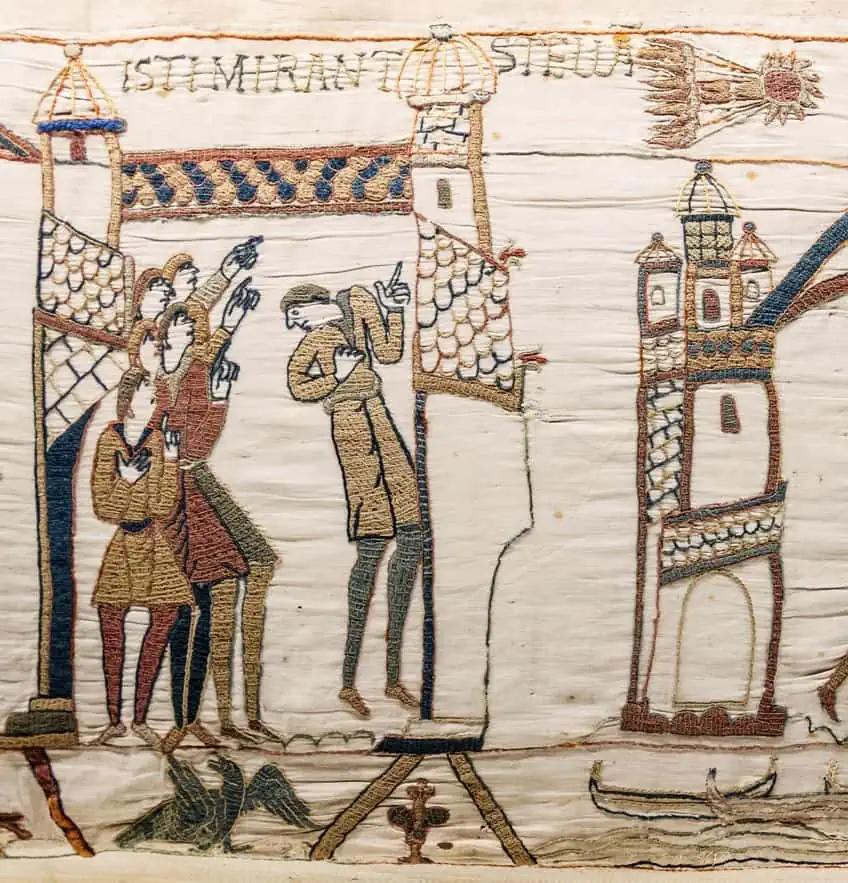
Before spreading to other Western nations like Spain, Germany, and Italy, the styles that were used during the Romanesque period were formed in France. It was the dominant artistic movement that spread throughout Europe, demonstrating the growing wealth of European cities and the power of Catholic monasteries.
The Norman art movement of the Romanesque era finally made it to England, where it flourished until the arrival of the Gothic art movement.
Gothic Period (1150- 1450 CE)
The Gothic art period, which started to emerge in the 12th century, was the final phase of late Medieval art. Romanesque art gave way to Gothic art during the reconstruction of the Abbey Church of Saint-Denis in France. As it gained popularity and expanded throughout Europe, Romanesque art was eventually completely replaced. In a clear reversion to reality, Gothic art was distinguished using bolder colors, size, and perspective.
The use of shadows and light in artwork increased, and artists started experimenting with the diverse and novel subject matter. As these new subjects included animals and mythical settings, religion was discarded as the key component in art. As paintings got more lifelike during the Gothic era, figures were shown using increasing realism.
As cities grew, the development of education, commerce, and creation resulted in the emergence of a completely new class that could unexpectedly afford to order works of art. As a result, Medieval artists were able to explore more secular and non-Christian themes and subjects in their works. The gothic architecture provided some ground-breaking structural innovations that allowed for the construction of taller, lighter buildings.

Like architecture, sculpture during this time period mostly served to adorn the exterior of cathedrals and other places of worship. As the artistic era shifted, aspects started to converge, and ultimately Gothic art transformed into Renaissance art.
Characteristics of Medieval Art
he Medieval period was very diverse, and a wide variety of mediums were tested. Tapestries, sculptures, illuminated manuscripts, stained glass, metalwork, and mosaics are among the works of art that still exist in significant numbers. Although they were all very popular throughout Medieval Art, it was claimed that they all had higher chances of surviving than fresco wall paintings and works made of precious metals. The most major Medieval art materials and some of their qualities are discussed here.

Medieval Paintings
Religion eventually evolved into a recurring motif in most of the artworks created during the Medieval era. Early in the Medieval era, vivid paintings with well-known saints, like Jesus and the Virgin Mary, were widespread. The Last Supper by Giotto di Bondone, painted in 1306, is one of the most famous religious works produced at this time. The apostles of Jesus are featured in this artwork, which afterward became the most frequently represented religious scenario in art history. When the Gothic art movement arrived, however, painters started to veer away from using common religious motifs in their paintings. As a result, paintings started to concentrate on mythology, animals, and other topics that deviated from the usual, changing both the subject matter and the art style.
Realism was one distinct creative component that artists started incorporating into their works, and it became a significant aspect of the paintings produced during the Medieval period.
Medieval Sculptures
The sculptures produced during the Middle Ages also included elements of realism. Sculptures had historically stylized facial characteristics before the fall of the Roman Empire. Following the fall of the empire, the Ottonians and Carolingians introduced realism by emphasizing the use of realist aesthetics over the uncaring emotions that were prevalent in times like the Byzantine Empire. An important phase of cultural resurgence in Medieval art was launched by this shift toward realism. Beautiful ivory sculptures and three-dimensional metal casts started to reappear.
The artworks were inspired by classical realism, which had outlived earlier art styles and found inspiration during the Medieval period.
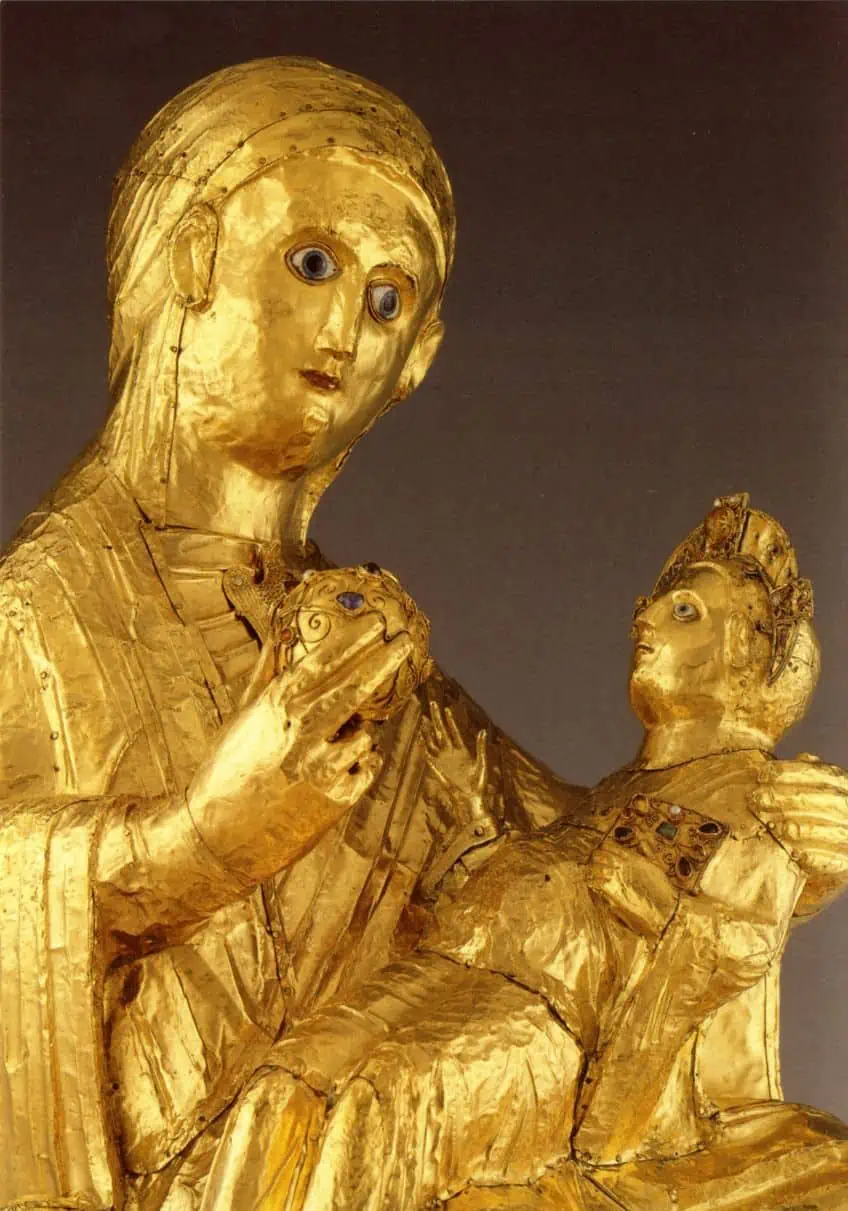
The variety of architectural sculptures discovered during the Romanesque and Gothic periods can be attributed to the many kinds and types of sculptures that came and went because of the scope of Medieval art. Notable medieval statues featured engravings of the Virgin Mary and the figurines that adorned great churches’ exteriors.
The scale of sculptures also indicated a person’s riches, with large marble monuments existing as symbols of exorbitant wealth and smaller ivory statues being considered purely devotional items.
Medieval Architecture
What formed a notable part of artistic developments during the middle ages art period was architecture. Political order during the Medieval era was basically not part of the society, which created a life that was difficult to live for the common people of the times. Religion and the knowing that there was peace in heaven, where happiness was finally to be experienced, was the only hope of certainty that existed for these people.
Due to the significant impact that religion had on society, churches were built by common people rather than by clergy, allowing these sacred spaces to accommodate the needs of their followers daily. As well as churches being places of worship, they became places for other everyday uses, such as museums, libraries, and picture galleries.
Throughout the Middle Ages, churches served a variety of purposes and evolved into the hub of town life. The churches that were constructed during this time period serve as illustrations of the Christian and Catholic faith’s great emotion and idealism. These structures were created as a clear representation of the spirituality of the civilization at the time, with the interior design showing the eager statement of the people’s intense religious belief in the Medieval era.
Illuminated Manuscripts
Illuminated manuscripts, a kind of art that gained prominence during the Middle Ages and contained texts embellished with decorative elements, were one such creation. The bulk of illuminated manuscripts that are still on display in art archives today date from the Medieval period of art.
The process of creating illuminated manuscripts was costly and time-consuming, and it started with the printing of the content onto parchment paper.
After this was finished, a protracted stage of preparation started in which the layout’s empty places were decorated. Beautiful images were then painted onto these pages in the last stage, frequently using gold, which was a preferred hue in the oldest manuscripts that were produced.

The formation of the historiated letter is one of the distinctive styles that resulted from the illuminated manuscripts’ extensive growth. This was a huge, frequently embellished letter used to introduce paragraphs and other text parts that frequently included images. Prior to growing in popularity during the Romanesque era, this was initially seen in Insular art.
These ornate initials can still be seen in volumes of myths and stories that draw inspiration from antiquity, demonstrating the significant impact illuminated manuscript production had on the evolution of art.
Stained Glass
The craft of stained glass was yet another magnificent kind of art that was popular during the Medieval era. Sand and wood ash were combined to produce this work of art, which was then melted into a liquid and shaped into glass. Powdered metals were added to the glass before it had fully solidified, giving the glassworks that subsequently graced enormous cathedrals their stunning colors.
The sort of stain and materials used would determine the colors, which were extraordinarily vivid, but no matter the combination, spectacular landscapes of awe were always assured.
These stained-glass works of art required a great deal of time since many glass pieces had to be meticulously assembled before the finished pattern and design were chosen. Before assembling the finished piece of art and fastening it to a window, artists applied any last finishing touches by hand. As these stained-glass creations were mostly employed to embellish the windows of churches and cathedrals with cherished symbols from the Bible, religion was another key element in their creation.
Famous Medieval Artworks
One of the best ways to understand the styles of different periods of medieval artwork is by exploring some examples. We have chosen two of our favorite and most famous examples of medieval paintings and statues to give you some insight into the principles behind this style of art. We are sure that you will recognize the first one, but the second may be a new discovery for you. Both are from similar times and fall into the Byzantine period of medieval art, so you should see an overlap in the stylization of the human form! Let us take a look.
The Last Supper by Leonardo Da Vinci (1495 – 1498 CE)
| Artist | Leonardo da Vinci |
| Date of Creation | 1495 – 1498 |
| Place of Origin | Convent of Santa Maria delle Grazie, Milan, Italy |
| Materials | Oil on wall |
| Dimensions (cm) | 460 x 880 |
The painting depicts Jesus and his disciples at the Last Supper, a ritual meal Jesus shared with his disciples before he was crucified. The painting is known for its realistic depiction of human figures and for its detailed faces and lifelike poses. The last supper shows Jesus and his disciples at the Last Supper. Jesus is seated at the head of the table holding a bowl of bread. The disciples are arranged around the table, conversing with each other.
The painting also contains many symbolic elements that refer to the events of the Last Supper.
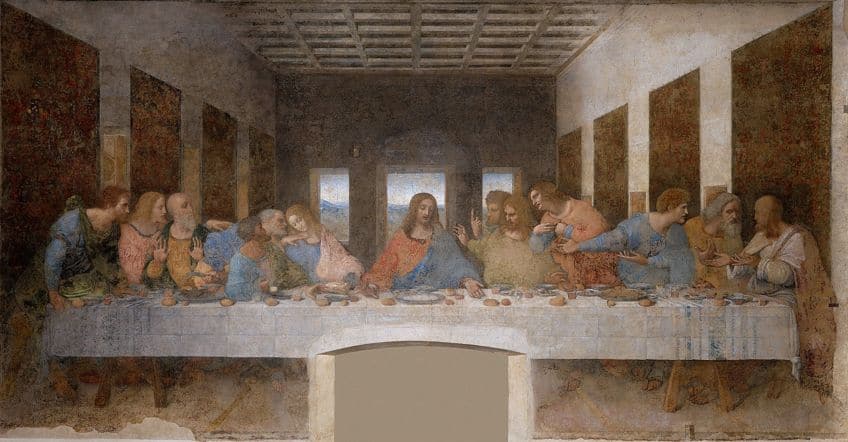
Bamberger Reiter from Stephan Lochner (1460 CE)
| Artist | Stephan Lochner |
| Date of Creation | 1460 CE |
| Place of Origin | Bamberg, Germany |
| Materials | Bronze |
| Dimensions (m) | 2,60 |
The statue shows a rider on a horse, dressed in full armor and holding a lance in his hand. The Bamberg Horseman is one of the most famous works of art in the city of Bamberg and is considered a symbol of the city. It is located on the market square in the old town and is a popular photo motif for tourists.
The statue was created in the 15th century by the artist Stephan Lochner and probably represents a knight who ruled at the time of the Hohenstaufen dynasty. It is made of bronze and has a height of 2.60 meters.
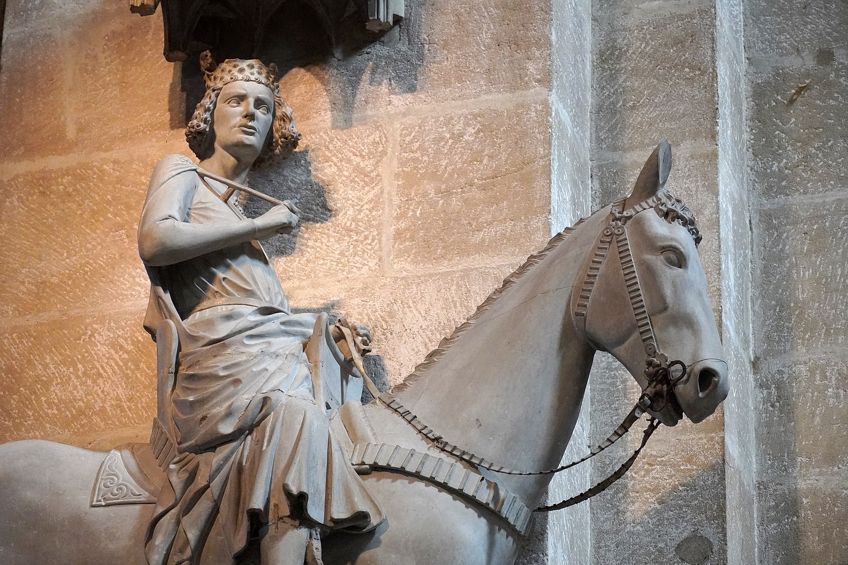
After reading this article, you should now be a lot more familiar with the different styles and eras of medieval art. A large variety of different artistic mediums were used to create Medieval art. These mediums included sculpture, illuminated manuscripts, tapestries, stained glass, mosaics, and metalworks. We can see many of these themes persiting in modern art.
Frequently Asked Questions
What Is the Middle Ages Art Style Called?
Art historians typically divide Medieval art into the following time periods: early Medieval art, Romanesque art, and Gothic art, despite the fact that the Middle Ages don’t precisely begin or conclude at any one point in history.
What Defines Medieval Art?
In addition to sculpture, illuminated manuscripts, tapestries, stained glass, metalwork, and mosaics, Medieval art also refers to a variety of media. Early Christian churches, Northern European so-called barbarian artistic culture, and the artistic legacy of the Roman Empire all influenced early Medieval art in Europe.
What Makes Medieval Art Important?
The fervent interest and idealistic representation of the Christian and Catholic faith are depicted in Medieval art. The interior decoration of Middle Ages buildings and their architectural designs were fervent manifestations of their inhabitants’ intense religious beliefs.
Jordan Anthony is a Cape Town-based film photographer, curator, and arts writer. She holds a Bachelor of Art in Fine Arts from the University of the Witwatersrand, Johannesburg, where she explored themes like healing, identity, dreams, and intuitive creation in her Contemporary art practice. Jordan has collaborated with various local art institutions, including the KZNSA Gallery in Durban, the Turbine Art Fair, and the Wits Art Museum. Her photography focuses on abstract color manipulations, portraiture, candid shots, and urban landscapes. She’s intrigued by philosophy, memory, and esotericism, drawing inspiration from Surrealism, Fluxus, and ancient civilizations, as well as childhood influences and found objects. Jordan is working for artfilemagazine since 2022 and writes blog posts about art history and photography.
Learn more about Jordan Anthony and about us.
Cite this Article
Jordan, Anthony, “Medieval Art – Different Themes and Periods in Medieval Art.” artfilemagazine – Your Online Art Source. February 13, 2023. URL: https://artfilemagazine.com/medieval-art/
Anthony, J. (2023, 13 February). Medieval Art – Different Themes and Periods in Medieval Art. artfilemagazine – Your Online Art Source. https://artfilemagazine.com/medieval-art/
Anthony, Jordan. “Medieval Art – Different Themes and Periods in Medieval Art.” artfilemagazine – Your Online Art Source, February 13, 2023. https://artfilemagazine.com/medieval-art/.


